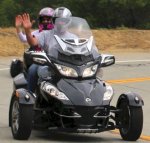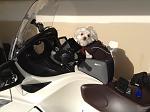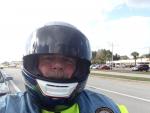|
-
Very Active Member

 Moto-Vlog - Bet you do not know your REAL tire pressure! Moto-Vlog - Bet you do not know your REAL tire pressure!
I bet you had no idea what your REAL tire pressure is?
This might surprise you when it comes to the rear tire on a Spyder!
Bob
2011 RT-S SM5 - Black
Bought June 2013 with 450 miles. 27K on 8-1-2017.
Farkles - DIY Trunk Break Light, HMT Break Light, DIY Mirror Turn Signal Lights, DIY Bluetooth Dongle, DIY iPod Setup, DIY Alarm System Install, Show Chrome front fender / rear saddle bag lights, 4th break light around the trunk, Vented Windshield, Baja Ron Sway Bar, DIY GPS setup, Smooth Spyder, BRP Chrome Mirrors, Adjustable deflectors, Triaxis handlebars, NVB Pegs, Bad Boy Airhorn... More to come 
-
Very Active Member


Wow, that is a substantial difference! I know that cage tires will heat up a few pounds, but not that much! I didn't catch whether you were running a car tire on the rear, Bob. I am assuming that you were riding one up when you got these readings. Or were you 2 up or tried 2 up and was there any pressure difference? Bet that is why the centers of our OEM tires are wearing out. They are turning into balloons on the freeway!
-
Ozzie Ozzie Ozzie

 That sort of pressure increase is expected and normal!! That sort of pressure increase is expected and normal!!
For what it's worth, some might find this useful - but you can take it or leave it as you prefer, it is a bit of a read, but I'm just putting it out there for those who might be interested! 
The specified tyre pressure on your tyre placard takes the fact that your tyre pressure will increase into account!! In fact, for many years the 'rule of thumb' for the optimum tyre pressure increase has been to aim for a 4psi increase after an hours worth of driving - so maybe your 28 psi is a little LOW for what you are doing/the way your ride/your load/the surfaces you ride on.... But do remember that while those 'specified pressures' are the best guess the vehicle & tyre manufacturer can come up with to work across the entire range of variables that their vehicle/tyres may meet in operation, the reality of it is that you and everyone else will have some slight differences that mean the absolute optimum tyre pressure for you is most likely going to be different than it would be for anyone else, even if they were riding your bike over the same roads at the same time of day.
Anyhow, if you want to fine tune your tyre pressures to the best balance between traction, ride, handling, and longevity on your bike, try using the 4PSI Rule - Bridgestone, Coopers, & Mickey Thompson are just a few of the tyre manufacturing companies that have published or referred to this 'Rule', but most tyre & vehicle manufacturers use it or some variation of it when calculating what pressures to specify. (have a search - 4psi Rule tyre pressures)
Briefly, to start out you need to check your tyre pressures when they are cold - ie, before you start riding for the day. If you don't have any idea of what to put in there to start with, you can use whatever you feel comfortable with, but the the specified pressure is usually a good place, this 'Rule of thumb' just allows you to fine tune your pressures and then set & confirm that you are running the right & optimum pressures for what you do! Just make sure that you are using a 'consistent' tyre pressure gauge - it's better that you have a gauge that consistently reads the same pressure when nothing else has changed than it is that you have a gauge sometimes reads absolutely accuractely, cos you'll need to take a few readings over a couple of weeks to work out what's right for you & consistency is more important than absolute accuracy. So start out knowing what your tyre pressure is from cold; then ride the byke for an hour or so (being dead on for that riding time isn't essential, it's just that your tyres need to be well & truly warmed up!) Then take another pressure reading with your consistent pressure gauge. The aim is to get a 4PSI increase in tyre pressure after about an hours worth of riding. If you get LESS than 4psi, your start pressure was too HIGH, ie your tyres had too much air in them to flex enough & warm up 'properly', so your start pressure was too high and your ride, traction, handling, & tyre life will suffer over time, so you need to lower your start pressure. If you get MORE than a 4PSI increase after an hours riding, your start pressure was too LOW, ie your tyres had too little air in them and they flexed more than they should, overheating somewhat and adversely impacting your handling & tyre life over time.
Before someone asks (& someone always has) you don't actually hafta wait until your tyres are fully cold once more to vary your pressures, you can adjust your tyre pressures on the gojust so long as you remember that you are making adjustments to hot tyres that need to be reflected in the COLD start pressures you use next time your tyres actually are cold - and that any air you put in now is going to be (relatively) cold air that is being added to already heated air inside your tyres so it will increase in temp & expand fairly rapidly. First up, work out how much your tyre pressures have increased over the hour, so you can calculate the difference between what your tyre pressures should have been and what they actually are... Then, if the tyre pressure increased by more than 4psi, you need to ADD more air, so add just one half of the difference between the pressure 'should be' & 'actual' pressure (that allows for that rapid increase in temp/volume of the added air); and if your tyre pressures increase by less than 4psi, you need to reduce the amount of air in your tyres to let the compound in the tyre flex & warm up reach its correct operating temperature, so you let out just 1/2 of the difference between your 'should be' & 'actual' pressure. Remember to apply that change to your next cold start pressure, but if you are going on, you can ride for another hour & check the pressures again to confirm that you are getting closer to the pressrues that are right for you, your tyres, the surface you are ryding on, the load, and the ambient temperature of the day, yada, yada, yada.... And you can keep on doing that for as long as it takes you to get it down to so close you can't add or subtract the air to that amount of accuracy!!
Try it for a week or two, check your tyres before you start riding, then check them after an hour or so; make the corrections up or down as indicated by the increase; if the tyre pressure goes up by MORE than 4psi, ADD air now; if it goes up by LESS than 4psi, let air out now; but always add or let out only 1/2 the difference in pressure between what your pressure should have been and what it actually is. Remember that any changes need to be reflected in what you use as your 'normal' cold start tyre pressures, and if it's going to be a hotter day you might need higher start pressures to reduce the flex in the sidewall & minimise overheating, similarly if you are going to be riding longer or faster. It generally only takes a week or two of paying attention to your tyre pressures for most to work out fairly accurately what is the 'optimum' pressure for them & their tyres plus all the variables they include in their daily riding; and you can always vary your cold start pressures up or down if you change any of those variables!! And don't forget that as the rider, you also control a few of the other variables that can make your tyre pressures change - if you keep on needing more air pressures in your tyres as shown by the 'Rule', you might want to consider slowing down a little, or maybe braking &/or cornering less aggressively I(hah, it's a bike!! does anyone do that?!)
Over to you!
PS, you are more likely to wear out the middle of your tyre tread thru OVER-inflation than thru running a pressure that's too low, but that can also be effected by using/running different rubber compounds... softer compounds generally = better grip but less tyre life, while harder compounds generally need lower pressures to get the tyres up to their optimum operating temps and achieve their best grip... and every little thing that can change any variable that might impact on wear can & will, so none of this is anything much more than broad generalisations tested & proven reasonably reliable over time, but it is a consitent way of making sure that your tyre pressures are close to whatever pressures will give you the best balance between tyre life, ride, handling, & traction etc. If you want to get emphasise one of those then you can, but it comes at a cost elsewhere, eg, maybe you are after better traction, then sure, you can drop your tyre pressures a little, but you should realise that the better traction that might afford comes at the cost of losing out on some of the (potential) life of the tyre!
Last edited by Peter Aawen; 05-29-2015 at 02:41 AM.
-
Very Active Member

-
Very Active Member


Nitrogen also increases in pressure with temperature.
-
Very Active Member


 Originally Posted by jcthorne

Nitrogen also increases in pressure with temperature.
not as much as air
-
Very Active Member

 Did you notice? Did you notice?
Did anyone notice the fool on the two wheeler passing on between cars on the double yellow of the HOV lane? If he keeps that up, he won't have to worry about tire pressure anymore.
2011 RTS (Sold to a very nice lady)
1998 Honda Valkyrie
2006 Mustang GT. Varooooom!
US Navy Veteran
SC Law Enforcement Boat Captain
CNC Machine Service Technician
President: Rolling Thunder SC1
Member: Disabled American Veterans, Rock Hill, SC
Member: American Legion
Experience is recognizing the same mistake every time you make it!  
-
Last edited by Bob Denman; 05-29-2015 at 10:46 AM.
-
Very Active Member


 Originally Posted by Grandpot

Did anyone notice the fool on the two wheeler passing on between cars on the double yellow of the HOV lane? If he keeps that up, he won't have to worry about tire pressure anymore.
That be California, some folks are not the sharpest knife in the drawer! 
If I can't fix it, I will fix it so no one can fix it.  Sypder Loco! 
-
Very Active Member


There are racing tire gases with argon and other secret gases. This way the teams know what pressue to expect. This is when you get into 1/2 psi changes for set ups. I run nitrogen on my RS-S front at 16 and when hot in the twisties I see around 19 psi.
If I can't fix it, I will fix it so no one can fix it.  Sypder Loco! 
-

They're like that all over... 
-
Very Active Member


I surmise when you check your tires when they are cold the pressures will be lower than actually running down the highway and I bet manafacturer's are aware of the pressure increase thus they know what cold pressure to recommend to insure best handling when riding..
osm
-
Very Active Member


Answers:
Hey folks, in that video I AM RUNNING NITROGEN in the rear tire!!!!! I am still seeing that much of an increase! So imagine what the increase would be with regular air?
I am running a car tire. The Yokohama S Drive.
At ambient my tire pressure is 28. When it gets cold at night FOBO reports a drop to 27.
Bob
2011 RT-S SM5 - Black
Bought June 2013 with 450 miles. 27K on 8-1-2017.
Farkles - DIY Trunk Break Light, HMT Break Light, DIY Mirror Turn Signal Lights, DIY Bluetooth Dongle, DIY iPod Setup, DIY Alarm System Install, Show Chrome front fender / rear saddle bag lights, 4th break light around the trunk, Vented Windshield, Baja Ron Sway Bar, DIY GPS setup, Smooth Spyder, BRP Chrome Mirrors, Adjustable deflectors, Triaxis handlebars, NVB Pegs, Bad Boy Airhorn... More to come 
-
Very Active Member


I just wondering why an apparent commercial truck was in the car pool lane.
Phil
I may be old, but I got to see all the cool bands.
2011 Spyder RT-AC

-
Very Active Member


More answers 
1) In California it is legal to lane split. almost every 2 wheeler does it especially in rush hour traffic. The rule is no faster than 10 MPH over what the car in the same lane is doing. Believe it or not, it's pretty safe with the diamond lane double yellow. The only time I have seen accidents is when a cager changes lanes at the double yellow!
2) Single axel trucks like what you saw are allowed in the HOV lane! I hate it personally but they are.
Now here is something interesting that got brought up about how much the rear tire is heating up!
The CAT is right in front of the rear tire and the exhaust is along side it. This is probably adding to the large temp increase of the rear tire. A guy on Facebook said when he did the cat delete, the rear tire is now not changing near as much.
Bob
2011 RT-S SM5 - Black
Bought June 2013 with 450 miles. 27K on 8-1-2017.
Farkles - DIY Trunk Break Light, HMT Break Light, DIY Mirror Turn Signal Lights, DIY Bluetooth Dongle, DIY iPod Setup, DIY Alarm System Install, Show Chrome front fender / rear saddle bag lights, 4th break light around the trunk, Vented Windshield, Baja Ron Sway Bar, DIY GPS setup, Smooth Spyder, BRP Chrome Mirrors, Adjustable deflectors, Triaxis handlebars, NVB Pegs, Bad Boy Airhorn... More to come 
 Posting Permissions
Posting Permissions
- You may not post new threads
- You may not post replies
- You may not post attachments
- You may not edit your posts
-
Forum Rules
|

